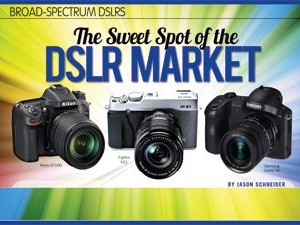
A broad-spectrum DSLR is one that appeals to multiple market segments—a great thing for dealers who want to maintain lean inventories and move merchandise quickly. Traditionally, the term has referred to broad-spectrum, entry-level models offered at price points low enough to entice first-time buyers upgrading from point-and-shoot cameras but with sufficient features and performance to attract budding and experienced enthusiasts. However, this once clearly defined category has been rapidly evolving over the past few years as technology has transformed the DSLR market and consumers have increasingly pursued a higher level shooting experience, more advanced features and something approaching pro-caliber performance.
From a marketing perspective, cameras like the Sony SLT-α58, Panasonic Lumix DMC-G6 and Olympus OM-D E-M5 all compete in the DSLR space, even though strictly speaking none of them is a single-lens reflex, which is defined as a camera having an optical viewfinder, mirror box and flipping reflex mirror. However, with their advanced, eye-level electronic viewfinders (EVFs), comprehensive feature sets and interchangeable lenses, these and other mirrorless or fixed-mirror cameras do provide the essential DSLR shooting experience.
Secondly, broad-spectrum or crossover DSLRs are no longer restricted to having one foot planted in the entry-level segment; they can now be middle tier models that appeal to a wide swathe of users ranging from emerging enthusiasts to seasoned enthusiasts and pros. Many of them also feature more robust, better sealed body construction and, not surprisingly, higher prices.
Establishing your store as the source of popular broad-spectrum DSLRs, offering a choice of models for a hands-on test drive, and having a knowledgeable staff dedicated to helping your customers make intelligent choices is clearly a winning strategy in today’s ultra-competitive market.
One thing that will probably never change is that DSLRs are the most efficient gateway to repeat sales, since DSLR shooters often upgrade their cameras more often, and for generating sales of high-margin accessories like lenses, flash units, filters, bags, tripods and practically everything else in your store. That’s why the broad-spectrum DSLR buyer is a customer well worth cultivating.
A Scintillating Selection of Eight Broad-Spectrum DSLRs
Olympus OM-D E-M5. While no longer the flagship of the OM-D line, this attractively priced camera looks like a downsized classic DSLR and provides high-level DSLR functionality in a small, light package. Its feature set includes: a 16 megapixel Micro Four Thirds High-Speed Live MOS image sensor coupled to a TruPic VI processor; a built-in, high-definition, eye-level electronic viewfinder providing a 100% view and an ultrafast refresh rate; a 3.0-inch, tilting touch-screen OLED monitor; and an innovative five-axis sensor-shift image-stabilization (IS) system that delivers shake-free images when shooting stills or 1,920×1,080 Full HD video handheld. Other features include: high-speed AF tracking; 3D tracking; a 9-fps burst rate; 11 built-in filters; ISO settings to 25,600; RAW + JPEG capture; and a dustproof, weatherproof, magnesium alloy body. $1,299 with 12–50mm Olympus M.Zuiko Digital lens. olympusamerica.com
Fujifilm X-E1. Here’s a cool concept: a serious enthusiast camera that provides DSLR functionality but looks and handles like a classic rangefinder 35, complete with analog dials! It delivers on its sleek high-tech image, too, with a 16.3MP APS-C-format X-Trans CMOS sensor that has a unique color pixel array claimed to reduce noise and increase resolution. It also offers an ultra-high-res 2.36-million-dot OLED eye-level viewfinder, a 2.8-inch, 460k-dot LCD monitor, Full HD 1980p video capture with stereo sound, an advanced EXR Processing Pro image processor, a focal-plane shutter, ISO settings to 25,600, and a rugged magnesium alloy body. The X-E1 uses a unique Fuji X-mount (with a 10-pin data bus) that’s only 2.5mm thick, contributing to the camera’s slim profile. $1,199 with XF 18–55mm f/2.8–4 OIS lens. fujifilmusa.com
Pentax K-50. This handsome, ergonomically contoured classic DSLR delivers many of the features of the former top-of-the-line Pentax K-5 IIs at an enticingly moderate price—and it can be ordered in 120 customizable color combinations. Its features include: a 16.3MP APS-C-format CMOS image sensor; an image-processing engine optimized for Full HD 1080p video recording at 30 fps; an advanced SAFOX IXi+ autofocus system; 77-segment metering; 6-fps bursts; a 3.0-inch wide-view, 921k-dot LCD; a bright 100% view optical pentaprism viewfinder; an in-body shake reduction system; ISO 100–51,200; 22 custom functions; auto picture and scene modes; filter effects; Eye-Fi card support; and a weather-sealed body. The K-50 uses rechargeable Li-Ion or AA batteries. $775.95 with DA 18–55mm f/3.5–5.6 AL WR zoom lens. us.ricoh-imaging.com
Panasonic Lumix DMC-G6. Sleekly styled, this high-performance Micro Four Thirds-format mirrorless camera delivers full DSLR form and functionality, with a 16MP Live MOS sensor paired with a cutting-edge Venus Engine image processor. It also features a 3.0-inch, 1,036k-dot high-res, tilting touch-screen LCD; a 1,440k-dot OLED Live View EVF; an ultrafast Light Speed AF system; and Full HD 1080p video recording at an impressive 60 fps with stereo sound in AVCHD and MP4 formats. It also provides built-in wireless and NFC connectivity to smartphones for image sharing on social media, and it can capture impressive 7-fps full-res bursts. An eye sensor provides auto-switching between the EVF and LCD. $749.99 with 14–42mm f/3.5–5.6 II lens. panasonic.com
Nikon D7100. A rugged, full-featured crossover DSLR that appeals to enthusiasts as well as pros, its signature features are: a high-res 24.1MP DX-format CMOS sensor and an advanced Expeed 3 image-processing engine. For maximum sharpness and detail, the usual low-pass optical filter has been eliminated, and it can shoot up to 100 images at 6 fps at full resolution. Other key features include: an advanced 51-point autofocus system with 15 cross-type sensors; a built-in flash with commander function; Full HD 1080p video capture at 60, 50, 30, 25 and 24 fps; a 3.2-inch, 1229k-dot LCD; a pentaprism optical viewfinder with OLED display; built-in HDR; dual card slots; ISO 100–25,600; and an integrated I-TTL flash plus Speedlight compatibility. It’s all built into a robust, weather-sealed magnesium body with a comfy ergonomic grip. $1,599.95 with AF-S DX Nikkor 18–105mm f/3.5–5.6G ED VR lens. nikonusa.com
Canon EOS 70D. The high-tech, signature feature of this exciting new broad-spectrum, middle tier DSLR is Dual Pixel CMOS AF technology, where each pixel on the 20.2MP APS-C CMOS sensor integrates two separate photodiodes to provide both image capture and autofocus functions. The result is a broad, dense network of phase-detection sites across the entire frame area, providing faster AF and enhanced focus tracking that’s especially important when shooting HD video and high-speed, full-res bursts at 7 fps. This handsome, ergonomically contoured machine also features: Canon’s top-of-the-line Digic 5+ image processor; a 3.0-inch, 1,040k-dot, vari-angle touch-screen LCD; Full HD 1080p video capture at 30, 24 and 25 fps; a 19-point all cross-type AF system; ISO 100–12,800, expandable to ISO 25,600; a IFCL 63-zone Dual Layer metering system; built-in HDR and multiple exposure modes; filters; and scene intelligent auto mode. $1,349 with EF-S 18–55mm f/3.5–5.6 IS STM lens. usa.canon.com
Samsung Galaxy NX. The only DSLR that uses an Android 4.2 Jelly Bean operating system, the new NX provides 3G/4G LTE and Wi-Fi connectivity that not only allows users to share and back up their images to the cloud automatically but, with the proper apps, lets them access their e-mail or call friends on Skype! In addition to awesome connectivity, the NX has some pretty impressive camera credentials, including: a 20.3MP APS-C-format CMOS sensor; a DRIMe IV image signal processor; a high-res SVGA electronic viewfinder; an advanced hybrid (contrast- plus phase-detection) autofocus system; a zippy maximum burst rate of 8.6 fps; and a really huge 4.8-inch, 921k-dot LCD touch-screen monitor. The NX can capture Full HD 1080p video at 30 fps and offers extensive in-camera image-processing functions. $1,699.99 with 18–55mm lens. samsung.com
Sony SLT-α58. Delivering enthusiast-level performance and capabilities at an entry-level price, this attractive Translucent Mirror technology camera offers such high-end features as a 20.1MP Exmor HD APS-C-format CMOS sensor combined with an advanced Bionz image processor. It also boasts: a brilliant SVGA, 1440k-dot OLED Tru-Finder EVF; a 2.7-inch, 460k-dot tilting LCD monitor; and a 15-point AF system with three cross-type sensors. It also has SteadyShot Inside sensor-shift image stabilization, an ISO 100–16,000 sensitivity range with noise reduction, 5-fps burst, built-in auto object framing (it captures an additional alternative frame of a camera-suggested composition), auto HDR mode and Full HD 1080i/1080p video capture at 60i or 24p fps. $499.99 with Sony DT 18–55mm f/3.5–6.6 SAM II lens. sony.com





